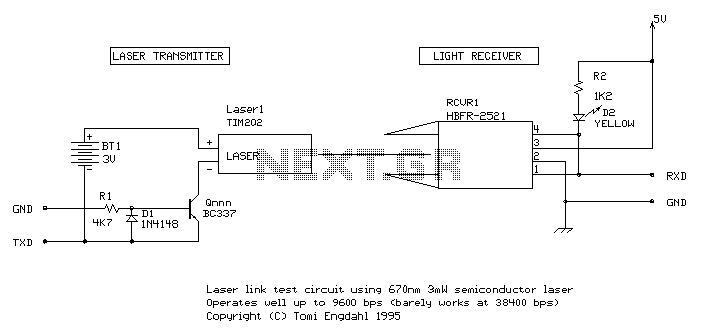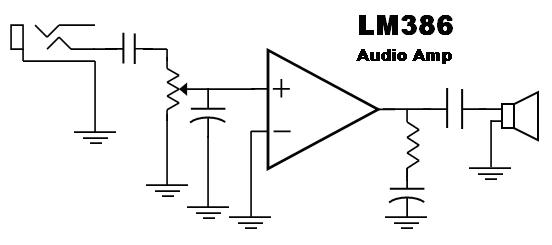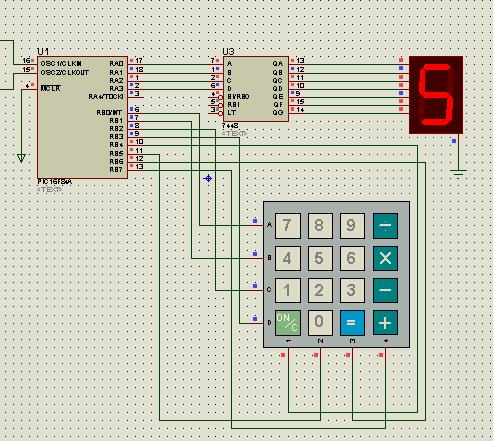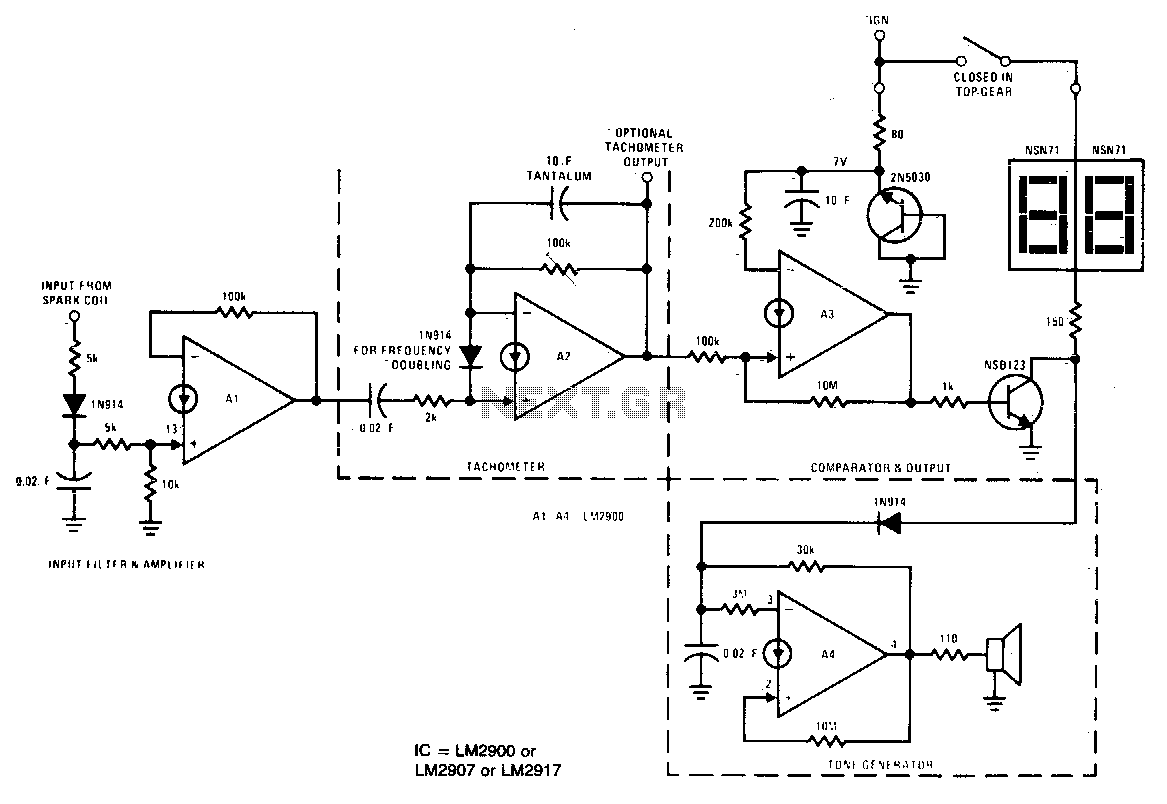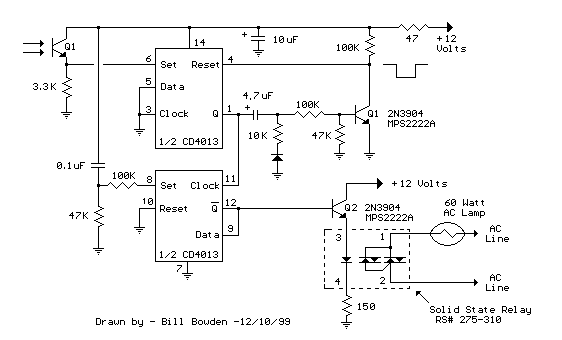
Laser Listening Device
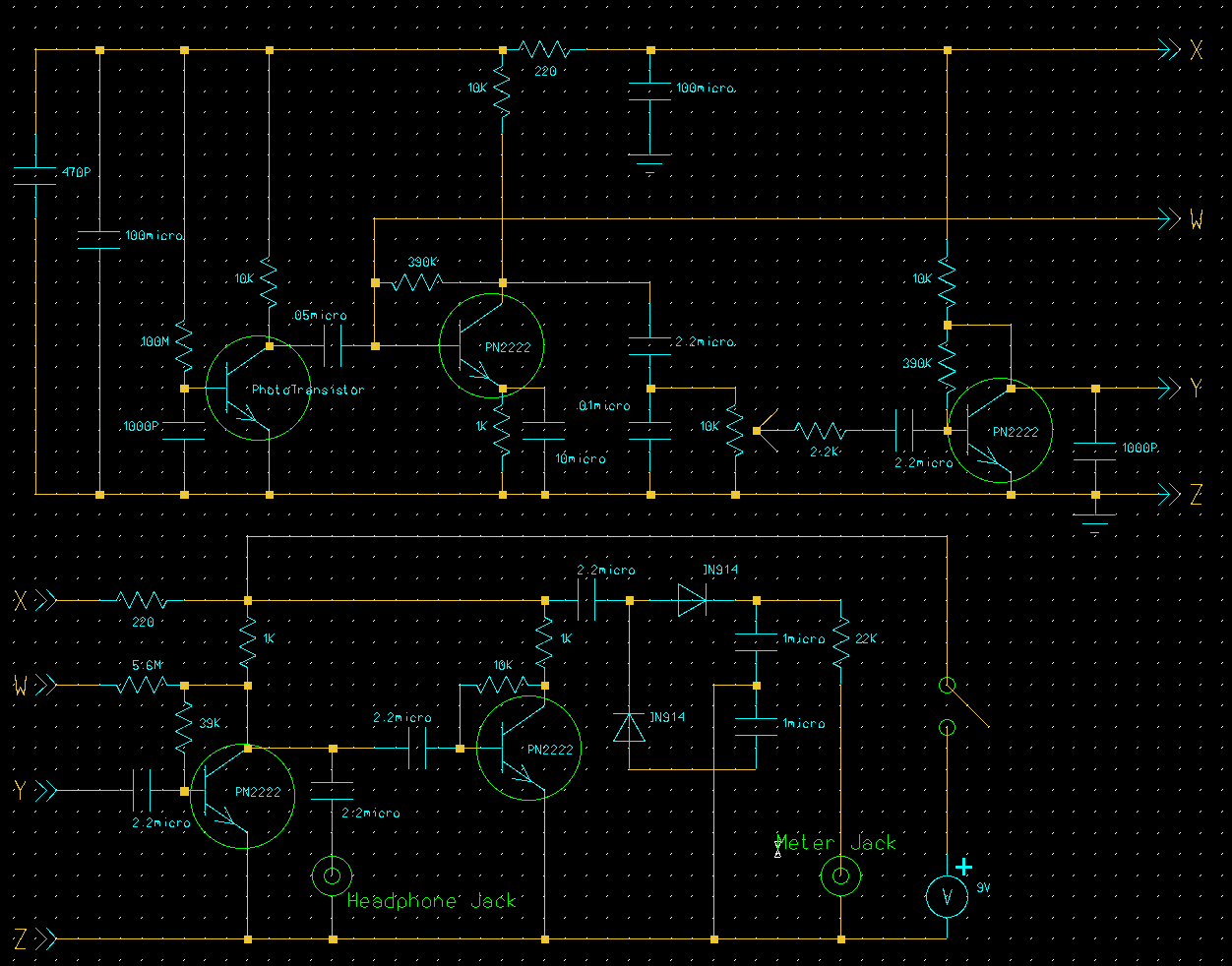
It has been observed that the receiver performed poorly when positioned at the center of the brightest spot of the reflected laser beam compared to when it was placed off-centered. This suggests that the circuit may have been saturated when the receiver was centered. In contrast, positioning the receiver off-centered allowed it to better analyze the weaker (less saturated) laser signal. This indicates that a lower energized beam can be more effectively modulated when interacting with the sound source. This finding implies that the laser may be effective over longer distances. Additionally, the thickness of the plane where the sound source is located can influence the receiver's ability to detect signal changes; a thinner plane vibrates more easily, facilitating better modulation of the laser. While it is noted that increasing the distance between the laser and the sound source may lead to greater beam divergence and weaker signals (which prevents circuit saturation), limitations to this approach exist. Employing lenses to converge a larger area of the reflected beam towards the receiver may enhance the laser snooper's range significantly, potentially increasing it from the current 30 feet to as much as 300 feet. Although this is not primarily an electronic project, a future design consideration could involve implementing Jake Janovetz's Napoleon 56K DSP board to filter out background noise. Background noise was notably present from the receiver, and utilizing the DSP board might improve the receiver's performance beyond its original design. This project has reinforced concepts learned in ECE342, such as using transistors to bias currents for varying voltage levels and employing capacitors to couple circuit points for stability.
The circuit under discussion utilizes various components to achieve its functionality. Key elements include resistors, capacitors, transistors, and diodes, each serving specific roles in the overall design.
Resistors R1 (100 MΩ), R2, R4, R10, and R15 (10 kΩ each), R3 and R8 (390 kΩ each), R5, R14, and R16 (1 kΩ each), R6/S1 (10 kΩ potentiometer and switch), R7 (2.2 kΩ), R12 (5.6 MΩ), R13 (39 kΩ), R17 (22 kΩ), and R9 and R11 (220 Ω each) are utilized to control current flow and set voltage levels throughout the circuit.
Capacitors play a crucial role in stabilizing the circuit and ensuring proper coupling between different points. Capacitor C1 (470 pF disc), C2 and C10 (100 µF 25V electrolytic), C3 and C9 (1000 pF disc), C4 (0.05 µF Mylar), C5 (10 µF 25V electrolytic), C6 (0.01 µF 25V disc), and C7, C8, C11, C12, C13, and C14 (2.2 µF 25V non-polarized) are employed for these purposes.
Transistors Q1 (L14G3 ultra-high sensitivity phototransistor) and Q2, Q3, Q4, and Q5 (PN2222 NPN transistors) are integrated into the circuit to amplify signals and control switching operations.
Diodes D1 and D2 (IN914) are included for protection against reverse polarity and to ensure proper signal flow.
The circuit also incorporates connectors, specifically J1 (RCA phono jack) and P1 (RCA phono plug), for interfacing with external devices. A battery clip (CL1) is utilized for power supply, and T1 (1 kΩ / 8 Ω mini audio transformer) is included to match impedance and facilitate audio signal transmission.
Overall, this circuit design integrates various electronic components to enhance the performance of the laser receiver, addressing challenges such as saturation and background noise while exploring the potential for increased operational range.Second, I have found that when the receiver was centered in the brightest spot (middle) of the reflected laser beam the circuit worked poorly compared to when the receiver was placed off-centered. This probably indicated that the circuit was saturated when the receiver was centered. And when it was off-centered, the circuit was able to analyze the weaker (less saturated) laser signal better. This must show that the lower energized beam was better able to become modulated when the beam was contacting the sound source. This can be useful in that this can mean that the laser can be sent at a longer distant to work even better.
And the thickness of the plane where the sound source is found can also affect the performance of the receivers capability to detect any changes in the signal. The thinner the plane, the easier it will vibrate and the better for the laser to be come modulated. Although it was said that the greater the distance the laser and the sound source the better the chance the laser will diverge larger giving a weaker signal (which prevents the over-saturation of the circuit) there will come limitations to this process.
So, using lenses to converge a larger area of the reflected beam to the receiver will help increase the range of the laser snooper even more. It was printed that the range may be as large as 300 feet versus the current 30 feet range. Although this isn`t really an electronic project, one way to think about as a future design is to implement Jake Janovetz`s Napoleon 56K DSP board to filter out background noise.
Background noise was very present from the receiver, and using the DSP board might have helped out in making the receiver work even better than it was designed for. This project has helped me relearn the theories learned from ECE342. Transistors were used to bias currents yielding different voltage levels. And capacitors were used to couple points of the circuit to stabilize. R1 1 100 Meg 1/2 Watt Resistor R2, 4, 10, 15 4 10 K 1/4 Watt Resistor R3, 8 2 390 K 1/4 Watt Resistor R5, 14, 16 3 1K 1/4 Watt Resistor R6/S1 1 10 K Pot and 12 V Switch R7 1 2.
2 K 1/4 Watt Resistor R12 1 5. 6 Meg 1/4 Watt Resistor R13 1 39 K 1/4 Watt Resistor R17 1 22 K 1/4 Watt Resistor R9, 11 2 220 Ohm 1/4 Watt Resistor C1 1 470 Pfd Disc Cap C2, 10 2 100 Mfd 25 V Elect Cap C3, 9 2 1000 Pfd Disc Cap C4 1. 05 Mfd Mylar Cap C5 1 10 Mfd 25 V Elect Cap C6 1. 01 Mfd 25 V Disc Cap C7, 8, 11, 12, 13, 14 6 2. 2 Mfd 25 V N. P. Cap C15, 16 2 1 Mfd 25 V Elect Cap Q1 1 L14G3 Ultra High Sen Phototransistor Q2, 3, 4, 5 4 PN222 NPN Transistor D1, 2 2 IN914 Diode J1 1 RCA Phono Jack P1 1 RCA Phono Plug CL1 1 9 V Battery Clip T1 1 1 K / 8 Ohm Mini Audo Transformer
🔗 External reference
The circuit under discussion utilizes various components to achieve its functionality. Key elements include resistors, capacitors, transistors, and diodes, each serving specific roles in the overall design.
Resistors R1 (100 MΩ), R2, R4, R10, and R15 (10 kΩ each), R3 and R8 (390 kΩ each), R5, R14, and R16 (1 kΩ each), R6/S1 (10 kΩ potentiometer and switch), R7 (2.2 kΩ), R12 (5.6 MΩ), R13 (39 kΩ), R17 (22 kΩ), and R9 and R11 (220 Ω each) are utilized to control current flow and set voltage levels throughout the circuit.
Capacitors play a crucial role in stabilizing the circuit and ensuring proper coupling between different points. Capacitor C1 (470 pF disc), C2 and C10 (100 µF 25V electrolytic), C3 and C9 (1000 pF disc), C4 (0.05 µF Mylar), C5 (10 µF 25V electrolytic), C6 (0.01 µF 25V disc), and C7, C8, C11, C12, C13, and C14 (2.2 µF 25V non-polarized) are employed for these purposes.
Transistors Q1 (L14G3 ultra-high sensitivity phototransistor) and Q2, Q3, Q4, and Q5 (PN2222 NPN transistors) are integrated into the circuit to amplify signals and control switching operations.
Diodes D1 and D2 (IN914) are included for protection against reverse polarity and to ensure proper signal flow.
The circuit also incorporates connectors, specifically J1 (RCA phono jack) and P1 (RCA phono plug), for interfacing with external devices. A battery clip (CL1) is utilized for power supply, and T1 (1 kΩ / 8 Ω mini audio transformer) is included to match impedance and facilitate audio signal transmission.
Overall, this circuit design integrates various electronic components to enhance the performance of the laser receiver, addressing challenges such as saturation and background noise while exploring the potential for increased operational range.Second, I have found that when the receiver was centered in the brightest spot (middle) of the reflected laser beam the circuit worked poorly compared to when the receiver was placed off-centered. This probably indicated that the circuit was saturated when the receiver was centered. And when it was off-centered, the circuit was able to analyze the weaker (less saturated) laser signal better. This must show that the lower energized beam was better able to become modulated when the beam was contacting the sound source. This can be useful in that this can mean that the laser can be sent at a longer distant to work even better.
And the thickness of the plane where the sound source is found can also affect the performance of the receivers capability to detect any changes in the signal. The thinner the plane, the easier it will vibrate and the better for the laser to be come modulated. Although it was said that the greater the distance the laser and the sound source the better the chance the laser will diverge larger giving a weaker signal (which prevents the over-saturation of the circuit) there will come limitations to this process.
So, using lenses to converge a larger area of the reflected beam to the receiver will help increase the range of the laser snooper even more. It was printed that the range may be as large as 300 feet versus the current 30 feet range. Although this isn`t really an electronic project, one way to think about as a future design is to implement Jake Janovetz`s Napoleon 56K DSP board to filter out background noise.
Background noise was very present from the receiver, and using the DSP board might have helped out in making the receiver work even better than it was designed for. This project has helped me relearn the theories learned from ECE342. Transistors were used to bias currents yielding different voltage levels. And capacitors were used to couple points of the circuit to stabilize. R1 1 100 Meg 1/2 Watt Resistor R2, 4, 10, 15 4 10 K 1/4 Watt Resistor R3, 8 2 390 K 1/4 Watt Resistor R5, 14, 16 3 1K 1/4 Watt Resistor R6/S1 1 10 K Pot and 12 V Switch R7 1 2.
2 K 1/4 Watt Resistor R12 1 5. 6 Meg 1/4 Watt Resistor R13 1 39 K 1/4 Watt Resistor R17 1 22 K 1/4 Watt Resistor R9, 11 2 220 Ohm 1/4 Watt Resistor C1 1 470 Pfd Disc Cap C2, 10 2 100 Mfd 25 V Elect Cap C3, 9 2 1000 Pfd Disc Cap C4 1. 05 Mfd Mylar Cap C5 1 10 Mfd 25 V Elect Cap C6 1. 01 Mfd 25 V Disc Cap C7, 8, 11, 12, 13, 14 6 2. 2 Mfd 25 V N. P. Cap C15, 16 2 1 Mfd 25 V Elect Cap Q1 1 L14G3 Ultra High Sen Phototransistor Q2, 3, 4, 5 4 PN222 NPN Transistor D1, 2 2 IN914 Diode J1 1 RCA Phono Jack P1 1 RCA Phono Plug CL1 1 9 V Battery Clip T1 1 1 K / 8 Ohm Mini Audo Transformer
🔗 External reference
